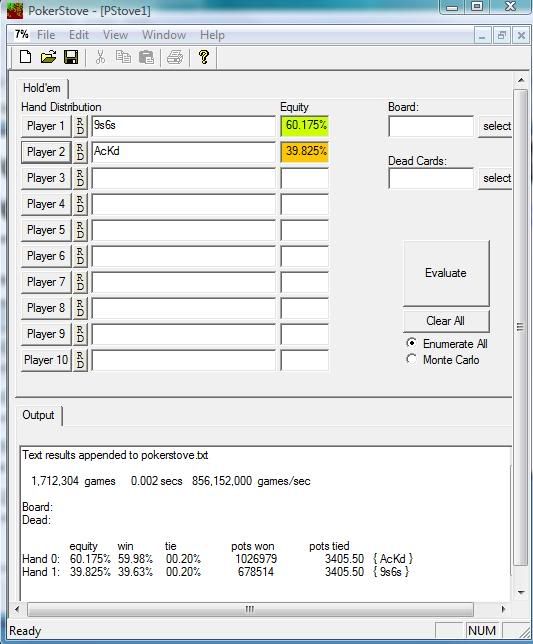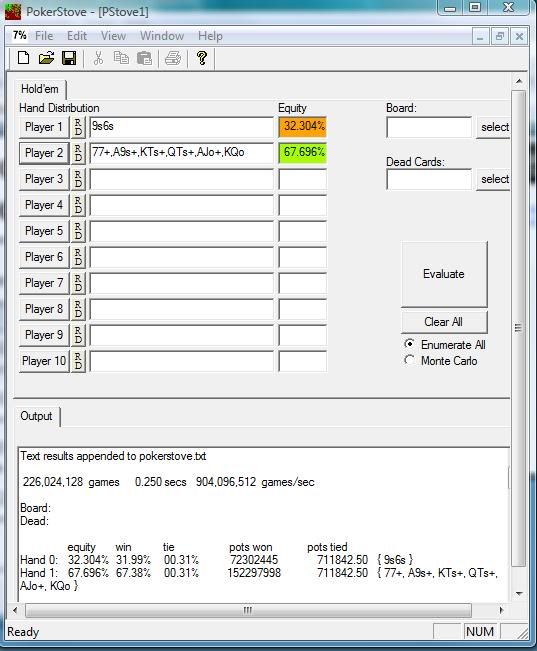ICM, as we recall from the last post, is simply a mathmatical model that lets us estimate the equity our stack has at any given point in a sitngo. To understand why this brought about a strategic revolution in the way we think about sitngos, perhaps it's best if I first explain a little of the history.
What we already knew about sitngos before all this ICM stuff came along.Sklansky talks about the 'gap concept' in his theory of poker, of requiring a better hand to call a raise with than we need to put in the raise ourselves. This is due to our chances of picking up the pot immediately when it's us who's doing the raising.
We know that this 'gap' is signifacantly widened in tournament poker where more than one place is paid, because of the disparity between the gain in our equity when we win chips and the reduction in our equity when we lose chips.
Even if we don't follow the mathematical logic, we've definately all absorbed through our collective cultural consiousness the practical consequences of this. Namely that we can raise with mince, but we need the goods to call.
In sitngos, with the ever increasing blind structure, people's stack sizes in terms of the number of big blinds they have goes down and down, and the number of chips available to win uncontested each hand if you raise and everybody else folds goes up and up.
So while everyone is getting gradually more and more desperate, the potential rewards of putting in a pre flop raise get more and more tempting.
Before long, we reach the point whereby any reasonably sized raise (ie, 2.5 or 3 times the big blind) will involve us putting a quarter of our stack in the middle and commiting us to the pot.
Note : Players still do sometimes fold pre-flop after they've raise a quarter of their stack (or more!)
Even some winning players do this (it's almost always a leak when they do) We're not going to, and are proceeding with the belief that it's weak, it's a leak and that we are to just say no!
Anybody who thinks otherwise, please see me after class.Raising and calling a re-raise is an option, but generally players will reraise you with cards that they wouldn't call you with had you gone all-in pre flop. We might know we're never going to fold, but they think there's still a chance. They're using Sklansky's gap concept too!
Most of the time we would much prefer to pick up the nice pot that contains just the blinds and antes, rather than flip a coin for our tournament life. To discourage your opponents from reraising you then, we just go all-in straight away. They now can't kid themselves that there's any chance of them winning t'pot without beating your ass in a showdown. They have to tighten up accordingly, and we get our wish of winning an uncontested pot more often.
PushbotsPushbotting, this strategy became known as. The bot being short for robot, ie the sitngo player employing this strategy is just playing robotically.
The desicion the pushbot has to make on each hand looked really simple, you either went all-in or you folded. (If someone else had gone all-in before you, you could call or you could fold.) Other poker professionals would look down on the push botter, "it's not proper poker" they would remark. I was a pushbotter for a long time and it never used to bother me. I was making money playing some sort of 52 card game, I wasn't too bothered what people called it.
Other players at the table would get frustrated by the push bot; I recall an angry chatbox comment made in my direction back in 2006 "Do you want to actually play some poker?"
"Ok" I replied, "but let's finish this sitngo first."
Enough guff about the good old days; you'll be pining for the Tribeca network next. Tell me about ICM ffs.I do beg your pardon, buisness will be resumed.
Sigh, this might take more than 3 posts.
Anyway, the pushbot strategy that sitngos necessitated was hardly the highly complex, multi faceted, minute to learn, lifetime to master beast that 'proper poker' puports to be. There was only one desicion, to push or to fold. Nevertheless a decision is still a descision, and any descion depends on...
Factors!Yes, the factors. Where would we be without them in poker?
(it depends)When weighing up whether to push or not to push, among the things a good push bot would consider were
- What winning the blinds is worth to them.
- How often they are going to get called by the opponents still to act.
- When they are called, what hands their opponent is likely to have.
- How often they are going to be able to beat those hands.
- What winning that all-in coup will be worth to them.
- What consequences will losing that all-in coup have for them.
You can think about these things at the table, and use our intuition, common sense and experience or (latent mathematical subconcious prowess even) to try to come to the best descion.
Away from the table though, it's always good to be able to quantify things, put some actual numbers onto some of our factors to help us make a more informed judgement. This is where some poker calculators came along, a pariticularly fine one still going strong today is called Pokerstove.
Pokerstove.Available to download (for free!) from
http://www.pokerstove.com/download/Here I have entered two hands to see how my


fairs against the mighty


when we're both all-in pre flop. I know I'm in bad shape, but I want to know how often I can expect to win the pot.
Very simple to do, anyone who has been apprenhensive about using poker software I would encourage to have a play about with a Pokerstove as they don't come simpler.
To replicate this experiment, after downloading and installing the latest version of Pokerstove, just click on the "Player 1" box, click on your two cards from the list of 52 and click 'OK'.
Then we click on the "Player 2" box and enter the two cards you want to run your cards against. After clicking OK again, press the big 'Evaluate' and then you'll get to where we are in this picture.
| Click to see full-size image. |

It has swiftly run through all the 1,712,304 possible combinations that five cards can be dealt from the remaining 48 cards (in 0.002 seconds) and calculates the equity that each hand has. Here we see my 96s has a win% of just under 40%, so we're going to bink about 4 times in 10.
(As an aside, that's about the same frequency that a good player can expect a top 3 finish in a single table tournament)Our chip equity it lists as 39.825% of the pot. We don't want to confuse this with the win% figure. The reason for the difference between the two is the occasional split pot.
We'd multiply our chip equity % figure, 39.825, by the size of the pot and divide by 100 to get our equity in terms of the number of chips we can expect to average.
Note : We don't want to confuse this chip equity with the equity we get from using the ICM model, so we'll call it cEV. (chip expected value)
All very nice and pretty, but in practise, we're never going to be in a situation where we know that if our opponent calls us, he has the exact hand


.
Range RoversWhat we might have though, is a good idea of the
range of cards our opponent might call us with. This idea of a "putting someone on a range" is central to the application of the ICM in sitngos.
As an example of a range, we might feel we'll get looked up by 77+ (which is shorthand for pocket 8's and all bigger pairs), A9s+, AJo+, KTs+, KQo+, QTs+ (which is the hands A9s, ATs, AJs, AQs, AKs, AJo, AQo, AKo... you get the idea)
This is an easy peasy job for Pokerstove to evaluate too. We click on 'Player 2', then 'Clear', then the 'Preflop' bar at the top. We can then select all the possible hands we think he'll call us with. (or in this case, slide the bar at the to 10.3%, meaning he'll call us with the top 10.3% of hands according to some hand ranking system, more on this later)
After we click 'OK' and 'Evaluate' we now get the following screen.
| Click to see full-size image. |

This time it's looked at over 226 million hands (in a quarter of a second!)
All the possibilities of the hands, and the resultant figures it spits out at us will be a weighted average* of how we will fare with our bold 96s against this range of hands.
*There are more ways to make AQo than there are to make AA. Pokeystove knows this. It also knows that it can't use


(ducy?

)
So, we can now see that 96s isn't quite so hot as before. When called by this range, we're only going to win just over 3 times in 10.
I'm breaking this post up into two parts now to make it a little more manageable. We continue below by going back to look at the main factors a push bot will have to consider when making his decision, and see how we're getting on attaching some good solid numbers to as many of them as we can.










